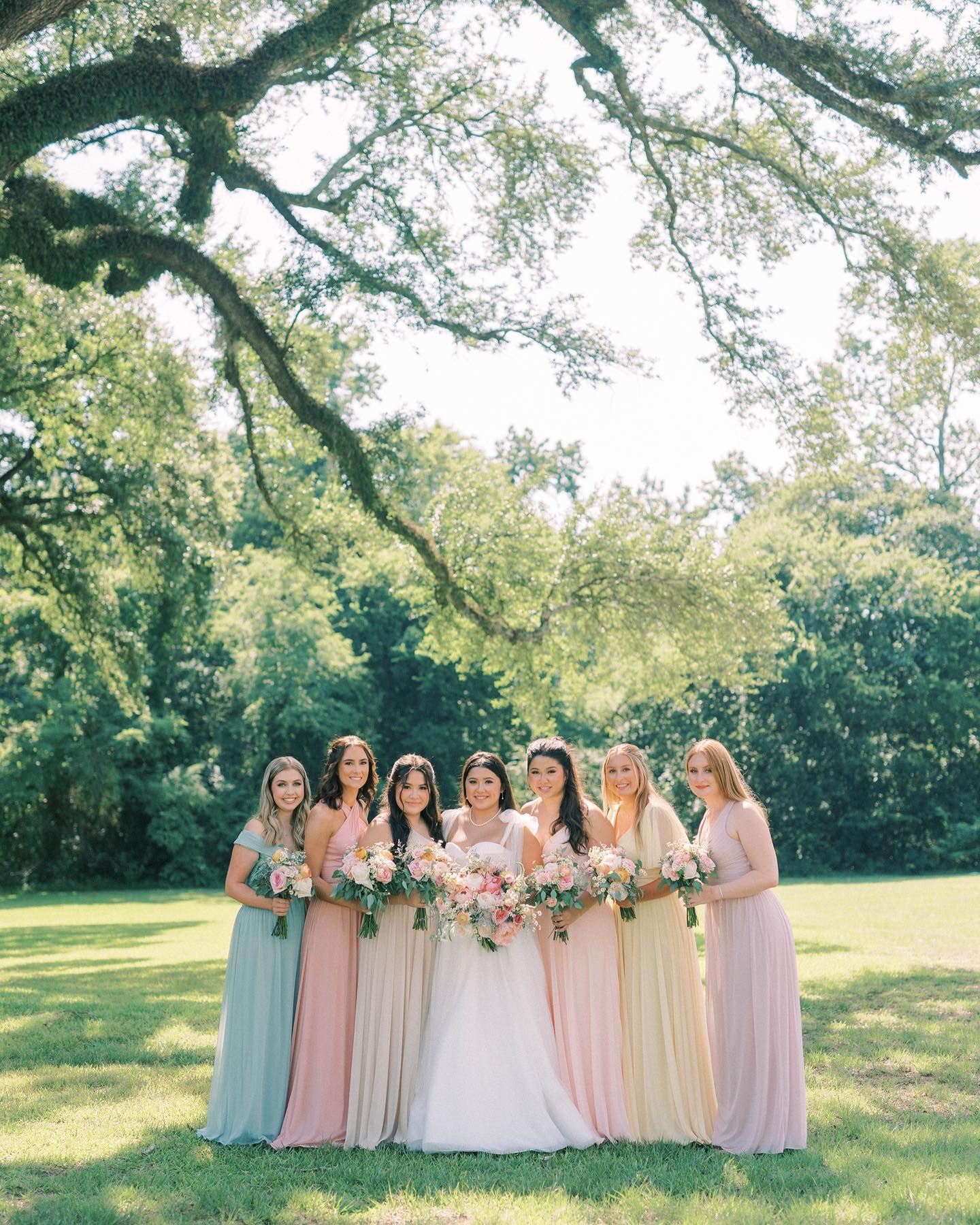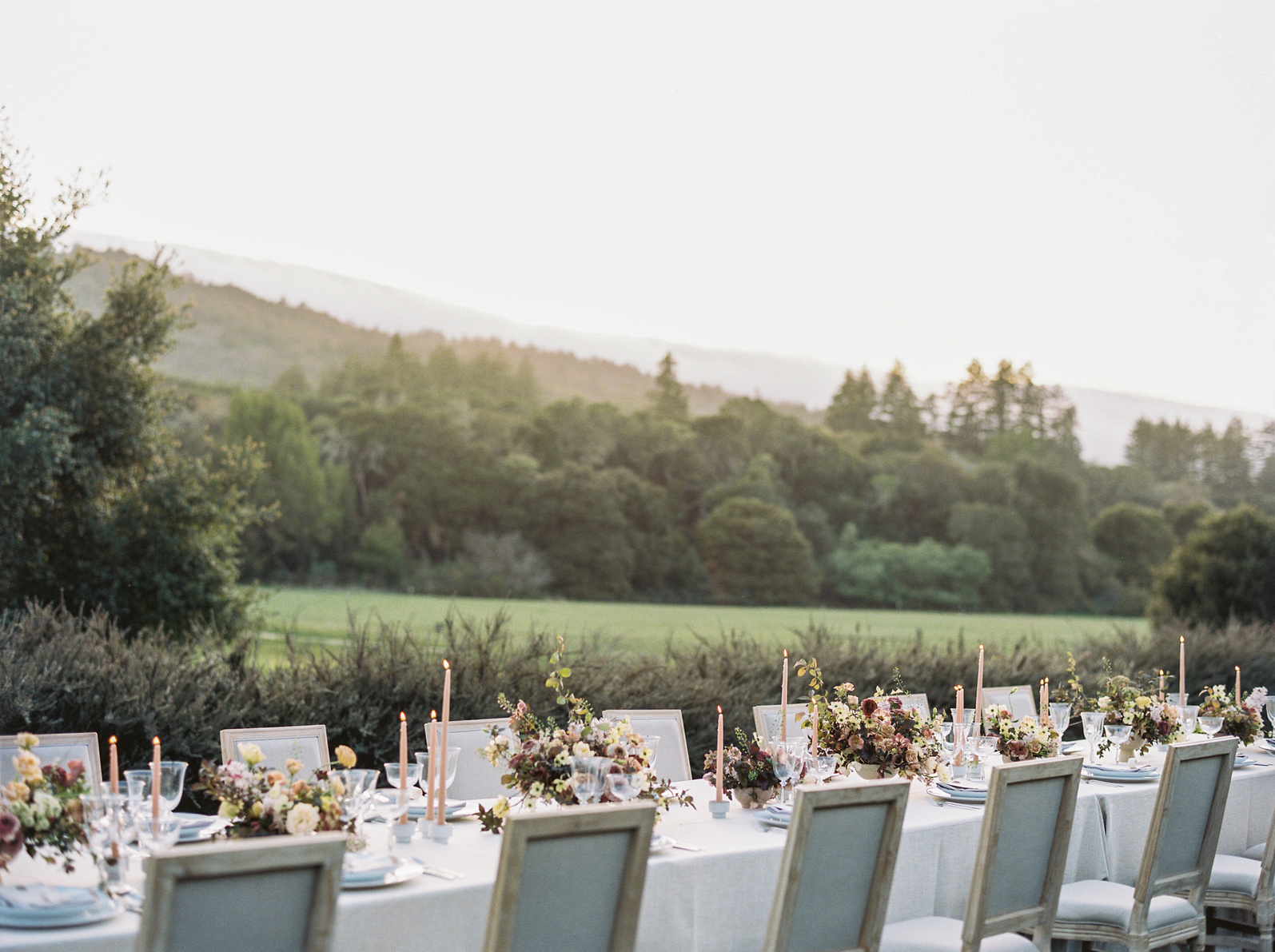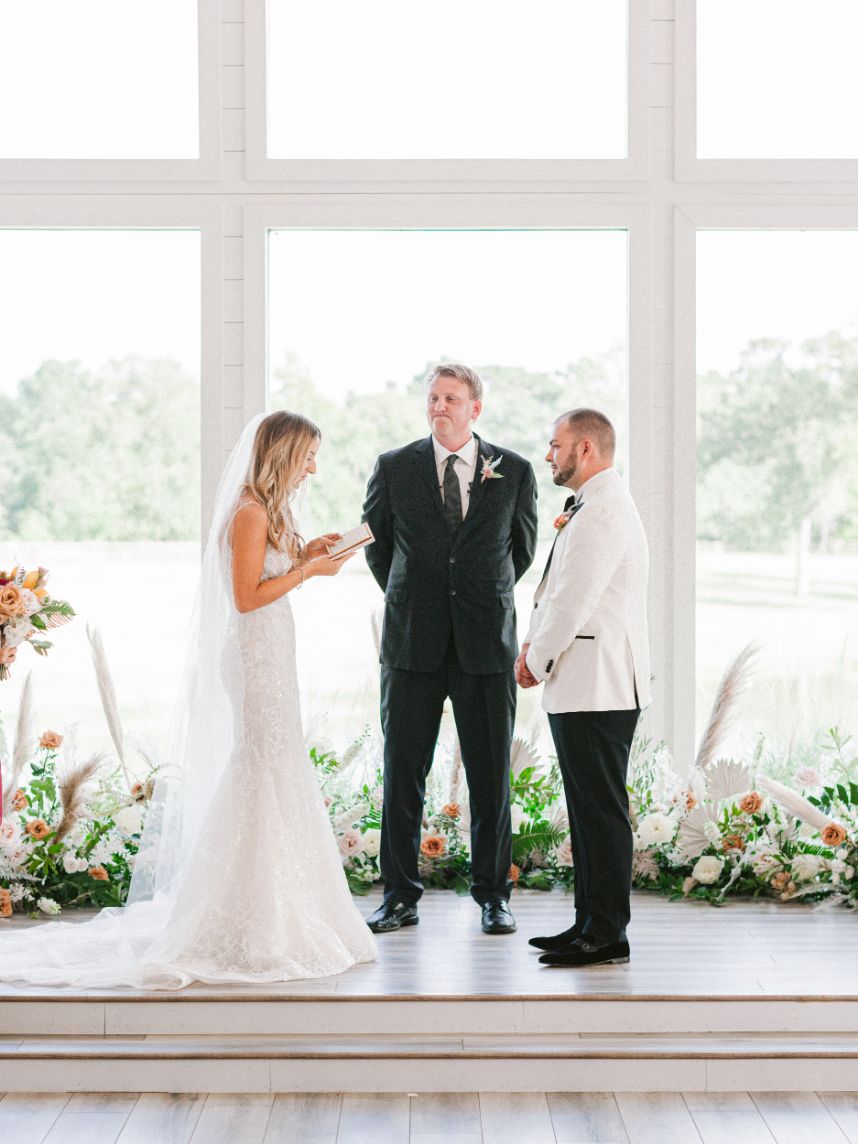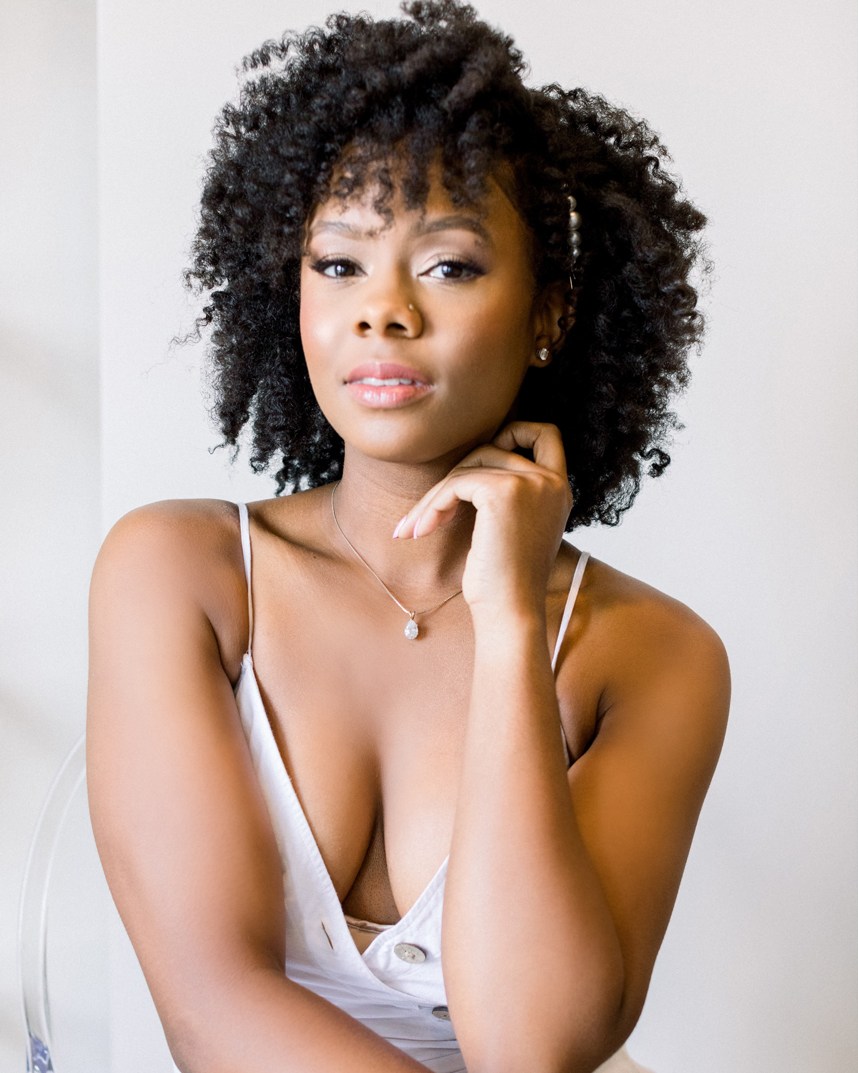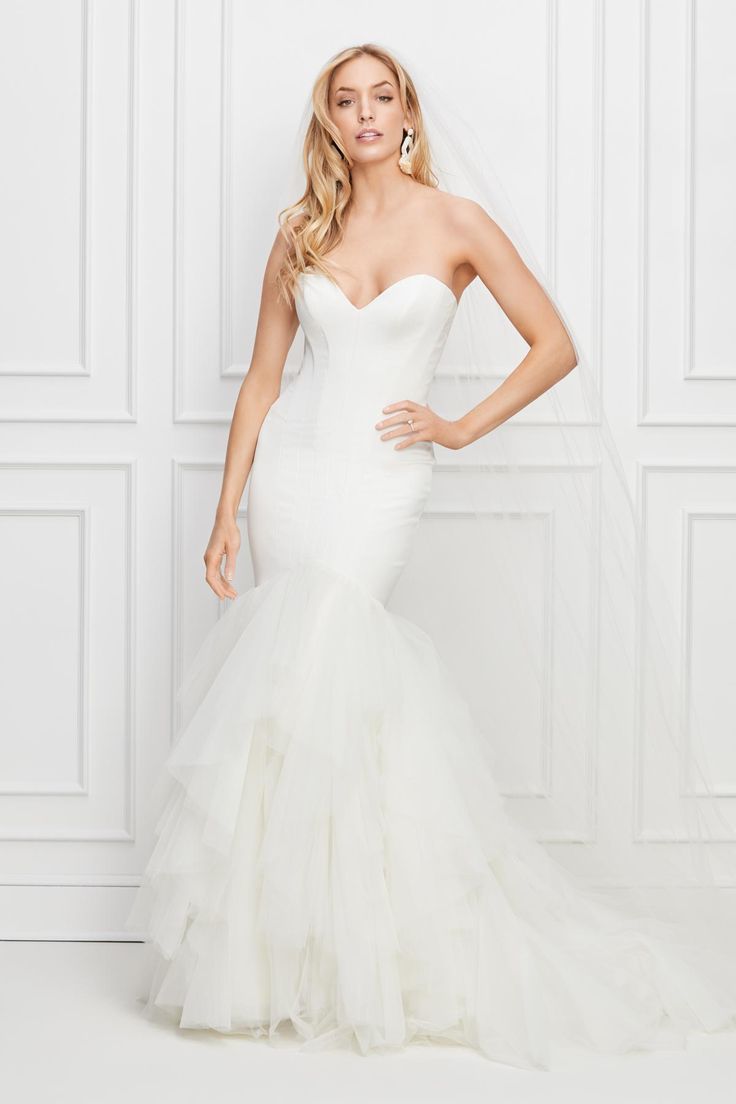First comes love, then comes walking down the aisle, then comes marriage! The bride’s walk down the aisle is always one of the highlights of a wedding day – however, she’s not the only one to take that walk during the ceremony. A few other important people, such as the officiant, groomsmen, bridesmaids and groom all make an appearance on the aisle before the bride makes her grand entrance. So, how should all of these people enter in the ceremony? Whether you’re the traditional bride or the bride looking for alternates to break tradition, we’ve laid out both the traditional wedding processional as well as alternates to making it your own based off of wedding party and couple preference. Read on for all the details, as well as to get our perfectly curated playlist for walkin’ down the aisle and a downloadable worksheet to help you construct your ideal processional. Cheers!

What is the traditional ceremony processional order?
Before jumping into the traditional order, you first need to know what a processional is. Essentially, the wedding processional refers to the group of people that walk down the aisle in a specific order to mark the beginning of a wedding ceremony. This is where anyone in the family, bridal party or other people close to the couple find their place in front of all guests before the ceremony begins.
The processional order for the traditional bride is as follows:
Mother of the bride: When the mother of the bride enters, that is the signal that the processional is about to begin. She can be accompanied by another family member (a son, nephew or cousin, if not in the bridal party) as she walks down the aisle, or she can opt to walk alone. Once she reaches the end of the aisle, she will take her seat on the left side of the aisle (traditionally) in the first row.
Officiant: Next in the processional order is the officiant. The officiant can be a friend, family member, or anyone ordained to perform weddings chosen by the couple. The officiant will make their way up to the altar and stand their while the rest of the processional makes their way forward.
Groom: The groom is the next to enter the ceremony space, entering from the side of the venue close to the right side of the altar, where traditionally the groom and his family are placed. However, many couples also choose to have the groom escorted down the aisle with both of his parents, who then sit on the right side of the aisle in the front row.
Best man: The best man then either walks in from the same side that the groom came from, or walks down the aisle alone. When they get to the front of the aisle, they take their place next to the groom at the altar in the closest spot behind him. The best man may also have the bride’s ring with him to give to the groom when needed.
Groomsmen: The groomsmen enter the ceremony space by walking down the aisle one by one. Groomsmen walk in order of who will be places farthest away from the groom to who will be standing by the best man.
Bridesmaids: The bridesmaids walk down the aisle one by one before the maid of honor enters.
*Some couples may choose to have the groomsmen and bridesmaids walk in together in pairs down the aisle. The same order of placement will follow – farthest away from the couple to the best man and maid of honor entering last.*
Maid of honor: Before the ceremony, the maid of honor helps the bride with any dress, veil, or train needs, making sure everything is perfect before they walk down the aisle. The maid of honor then stands by the bride’s side at the altar and holds their bouquet and sometimes the groom’s ring during the ceremony.
Flower girl and ring bearer: The flower girl and ring bearer are the final processional members to precede the bride before she walks down the aisle. Traditionally, the ring bearer carries the wedding rings tied to a small pillow, which is then handed to the best man (however, some couples opt to give the maid of honor and best man the actual rings to ensure they are not lost or dropped along the way). The flower girl may carry a basket full of petals to scatter as she walks down the aisle. Once both make it to the end of the aisle, they can find a seat with their parents or stay standing with the rest of the bridal party.
Father of the bride and bride: The father of the bride traditionally is the one who escorts their daughter down the aisle, standing to the right side of her as he does so. After the father of the bride “gives them away,” they lift the veil and kiss the bride, signifying their blessing, then take their seat beside the mother of the bride.
Is there a history to this order?
Many wedding traditions that we follow today derived from early Christian customs, in which the groom waits at the end of the aisle for his bride to walk down to him and stand at his side (not seeing each other before the wedding and the father walking the bride down the aisle, to name a few). Another tradition is that of bridal parties –which, as you know, consist of the bride and groom’s closest friends and family. In today’s weddings, bridal parties are seen as an honor by those asked to participate, but in early wedding party history, the role of the wedding party was for the bride and groom’s protection.
In early history, bridesmaids tended to the bride’s preparations in the days before the wedding and wore matching outfits. This was so that in the case that someone attempted to harm the bride, they would not be able to identify which of the women was the bride and which ones were her bridesmaids. This also was the case for the groom and his groomsmen.
The order of the wedding processional directly relates to the early purposes of the bridal party mentioned above. The first members that walked down the aisle in the processional hold a position of honor (the mother of the bride, the officiant and the groom) and mark the beginning of the ceremony. After those people take their places, the best man and the groomsmen traditionally walk down the aisle, in order to protect the groom from evil spirits or attackers. Then the bridesmaids make their way down the aisle, followed by the maid of honor. Following the tradition, the bridesmaids are intended to protect the bride from evil or harm prior to her walk. Once they are at the end of the aisle, the bride then begins to walk, traditionally accompanied by her father, so that he may give her away to her new husband.
Arranged marriages used to be the norm in society, serving as more of a business deal than anything. More than just not seeing one another on the wedding day, couples might have never even met one another before walking down the aisle (this was totally normal, and even expected in some cases). The deal was usually made by the bride’s father who wanted her to marry rich to help the family out. The father might worry that if the groom saw the bride before the ceremony he might not find her attractive and call off the wedding. To avoid risking the family’s reputation, the tradition that the couple didn’t see one another until the ceremony was born. The veil also plays a role here, too – by having it over the bride’s face he wouldn’t see her until the very last moment when it would be too late to back out.
How can a couple make the processional their own?
Not all wedding parties may have everyone included in the traditional order described above, and that’s totally fine! Some bridal parties might also include the growing trend of “bridesmen” or “groomswomen” – having the opposite sex in the bridal party. The traditional order also might just not be a good fit for you as a couple. Good thing there’s plenty of room for customization to make it your own!
Ways to switch up the traditional processional order:
- Have the officiant walk down the aisle first
- Have the officiant already be waiting at the end of the aisle
- Add grandparents into the processional order
- Have the groom’s mother walk him down the aisle
- Mix the wedding party up, alternating bridesmaid and groomsmen as they walk down the aisle
- For a blended family on the bride’s side, have the stepmother walk in behind your mother at the start of the ceremony
- Have all of your close family walk down the aisle before the traditional processional of bridesmaids, groomsmen and the bride and father of the bride
- Send in the groom (with or without his parents) right before the ring bearer and flower girl in the traditional order
DOWNLOAD OUR PROCESSIONAL WORKSHEET
Are there alternatives for fathers walking down the aisle?
Maybe you’re a bride who does not have a good relationship with her father, or maybe you do not have a father to walk you down the aisle – or, maybe you’re looking to break traditions.
Whatever the reason may be, there are a few alternate options to fathers walking down the aisle:
- Have the bride and groom walk in as a couple at the end of the processional
- Have both your mother and father walk you down the aisle
- Just the mother of the bride walks her down the aisle
- The bride walks in by herself
- Walk in with someone who means a lot to you, such as a grandparent, uncle or brother
- Walk in with your children if you have them
- Have your four-legged friend accompany you down the aisle
- Enter alone and meet your spouse in the middle of the aisle, then walk to the alter together
- Skip the processional and just walk to the front from wherever you may be at the time!
- To incorporate a stepfather and father on the bride’s side, have the stepfather walk the bride half way down the aisle to meet the father, who then take her to the altar
Need a song to walk down the aisle to?
Walking down the aisle doesn’t have to be boring – no matter what way you and your processional choose to do so! Looking for unique tunes to play when the big moment comes? We have the perfect playlist of hand-selected songs on our Spotify that’ll get you “Walkin’ Down the Aisle” in style!
PRO TIP: Having a curated playlist that you and your processional walk down the aisle to helps the order move along smoothly and gives your ceremony a bit more structure.
Download our wedding processional worksheet to use as you construct your ideal processional!




